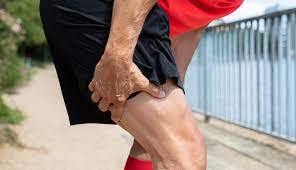Top Tips for Speeding Up Recovery After a Pulled Hamstring

The hamstrings are one of the most important muscle groups for runners, athletes, and people who live a physically active lifestyle. Unfortunately, hamstring strains are a common and painful injury. Athletes or anyone frequently sprinting, jumping, or lunging is at a greater risk for a strained hamstring. But what is a hamstring? A hamstring is a group of three muscles that run along the back of your thigh and allow bending at the knee. When a hamstring strain occurs, one or more of these muscles become overloaded. As a result, you are more likely to experience a strain during activities that involve sudden stopping, starting, and abrupt direction changes. You can be relatively sure you have experienced a hamstring injury if you hear a “pop” while exercising followed by pain. You may even have bruising and swelling in the hamstring area soon after.
Initial Treatment
After you strain or pull your hamstring, the question you may be wondering is, what do I do now? Directly after a strain, you should stop exercising immediately and begin R.I.C.E., which stands for rest, ice, compression, elevation. Rest in this case will include reducing regular exercise and any activity that causes stress on your hamstrings, like squatting or walking uphill. Next, the rule for icing is to apply ice for twenty minutes at a time, with at least an hour break in between. The sooner you can apply ice, the better. Compression can help to decrease and prevent swelling. Swelling can increase pain and slow the healing process, so utilizing a standard ACE wrap or any other medical wrap can be very useful. While for a strained hamstring, elevation may not be possible if the pain is in the upper buttock region, if the pain is in the lower leg, then elevation can be helpful.
Anti-Inflammatory Medications
Non-steroidal anti-inflammatory drugs (NSAIDs) like ibuprofen (Advil or Motrin) or Naproxen (Aleve) are known to help reduce pain and swelling. You can find these medications over-the-counter, and they are safe for most people. Still, you should always be sure to consult your doctor or pharmacist before you begin taking a new medication.
Stretches and Exercises
After the pain and swelling of your pulled hamstring have subsided, you should begin stretching and exercising. You should start gradually with hamstring stretches to help regain range of motion. In addition, strengthening exercises can be used to help you to restore muscle strength to prevent re-injury. You must never forget to warm up properly before exercising and stretching.
Using a Foam Roller
Using a foam roller can be very beneficial during your recovery from a pulled hamstring. Foam rolling is a way to self-massage targeting deep within the muscles to break apart scar tissue and reduce tension in the affected area. Although if bruising and swelling is still present, foam rolling should be avoided as it can worsen symptoms.
Conclusion
A pulled hamstring is a common and painful injury that can hinder your physical activity. However, in most cases, home treatment with R.I.C.E., medication, stretching, exercising, and using a foam roller can help to speed up recovery tremendously. If your strain is more severe or you are not finding relief at home, you will likely need the help of a medical professional. Your doctor is always the best place to start following any injury. Always consult them before you start treatment to ensure you are on the right path to recovery.
Featured Clinician: Anthony Maritato, PT
FEATURED CLINICIAN: Anthony Maritato, PT Anthony Maritato, PT, MSPT, is a licensed physical therapist and co-founder of Total Therapy Solutions, a private practice outpatient physical therapy business that focuses on
Colleen Rapp Wins Friend of Private Practice Award
Long time patient advocate, Colleen Rapp, was awarded the APTA Private Practice Section’s Friend of Private Practice Award during the 2022 PPS conference. Colleen has long been standing up for
Top Tips for Relieving Nerve Pain
Top Tips for Relieving Nerve Pain If you suffer from nerve or neuropathic pain, then you can certainly attest to how it can throw a wrench in your day-to-day routine.
How Your Diet Can Cause Inflammation
How Your Diet Can Cause Inflammation Depending on the situation, inflammation can be a good thing or a bad thing. It is good in that it is your body’s way
What to Avoid After Knee Replacement Surgery
What to Avoid After Knee Replacement Surgery Knee arthroplasty, otherwise known as knee replacement surgery, is designed to relieve pain and restore function in severely diseased knee joints. No matter
How Physical Therapy Can Help You Avoid Reliance on Pain Medications
How Physical Therapy Can Help You Avoid Reliance on Pain Medications If you suffer from chronic pain, you know how managing pain can be a real challenge. Another day, another
Kyle Yancey
Latest posts by Kyle Yancey (see all)
- Top Tips for Relieving Nerve Pain - October 28, 2022
- How Your Diet Can Cause Inflammation - October 25, 2022
- What to Avoid After Knee Replacement Surgery - October 19, 2022
- How Physical Therapy Can Help You Avoid Reliance on Pain Medications - October 13, 2022
- Physical Therapy for Heart Disease - October 11, 2022
